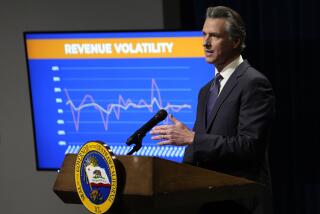Sobering Financial Outlook for City : Council Panel Told S.D. Will Face $783-Million Shortage
- Share via
San Diego’s city government will have to suck in its financial gut for some major belt-tightening by the year 2005, because it will be $783 million short of what it wants in roads, libraries, parks and storm drains, a City Council committee was told Wednesday.
The sobering forecast came from the city’s top financial officials, who warned council members that they face some tough political choices on how to trim their wish list, which includes a $65-million library downtown and a $95-million renovation of Balboa Park.
The officials said the shortfall expected during the next 20 years will be caused by two things, both expected to hit the city by 1988. First, the federal government will likely discontinue its revenue sharing program, which gives San Diego about $11 million a year.
The biggest blow, however, will be delivered by the Gann Initiative, a measure passed by California voters in November, 1979, that uses a complicated formula based on population growth and inflation to set a ceiling on local government spending. In San Diego, the burgeoning city budget will bump up against the Gann ceiling in 1988, when it will force officials to return approximately $3 million in the first year.
Carried out over the next 20 years, the effect of this double-whammy will be to leave the city $783 million short of what it wants to run such departments as police and fire, and to build and repair items such as park buildings, roads and street lights, city officials said.
“I believe we are choked and we have to do something about it,” Councilman Bill Cleator said during Wednesday’s presentation.
City officials said they based their calculations on a 20-year wish list provided by municipal department heads, and they expressed caution that the $783 million may not be an accurate number.
But they said the anticipated shortfall, whatever its size, will mean belt-tightening around City Hall. City officials may have to lower their sights and decide to build smaller parks or abandon some pet projects, said Libby A. Watson, the city’s financial management director.
Already, city staff members have identified 14 major construction projects that council members are pushing but for which there are no funds. Besides the new central library and a face lift for Balboa Park, there is the $33 million listed for open space acquisition, $70 million for Mission Bay Park development and an estimated $70-million revitalization of the Mid-City area.
“We are demanding 1 1/2 to 2 police officers per 1,000 people,” Watson said after the committee meeting. “We are demanding a new downtown central library. We are demanding a higher level of cleanliness at the beaches and the city parks. There’s a limit.”
Hardest hit by any shortfall would be established neighborhoods such as Normal Heights, Tierrasanta, Linda Vista, the Mid-City area and La Jolla, Watson said. Since developers are paying fees to build new streets, schools and parks in outlying areas under construction, the choices will become which roads will not be widened in the older areas.
Yet Watson stopped short of doomsaying. She said that even under the tight Gann restrictions, the city would still be able to “patch the roof and restucco the (city) buildings . . . all the things that we’ve been doing. It’s still a pretty damn good quality of life.”
The city could avoid the Gann restrictions if officials were able to persuade voters to override the measure, Watson said.
But that relief would only last four years before another vote would be required, and Watson said it is unlikely the voters would ever lift the Gann restriction because “there’s still a good segment of the population that thinks government is inefficient and wastes money, unfortunately.”
Even if voters lifted Gann during the next 20 years, and the federal government continued revenue sharing, San Diego would still face a $196-million shortfall for targeted projects, Watson said.
More to Read
Sign up for Essential California
The most important California stories and recommendations in your inbox every morning.
You may occasionally receive promotional content from the Los Angeles Times.










